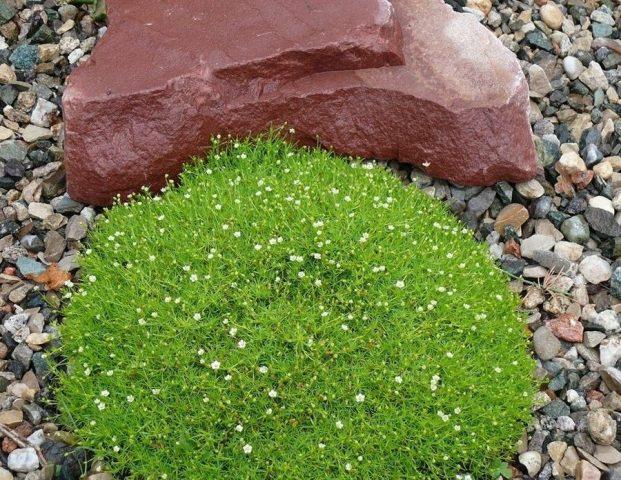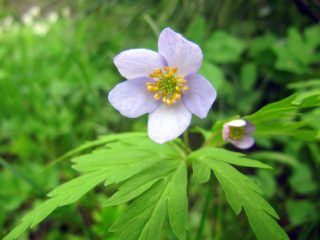Content
- 1 Description of the bryozoan subulate
- 2 Varieties of bryozoan subulate
- 3 Planting bryozoan awl-shaped seeds for seedlings
- 4 Planting bryozoan awl-shaped seeds in open ground
- 5 Rules of care
- 6 Reproduction of bryozoan subulate
- 7 How quickly does the awl-shaped bryozoan grow?
- 8 Diseases and pests
- 9 Is it possible to walk on bryozoan subulate?
- 10 Photo of bryozoan awl-shaped in the landscape
- 11 Conclusion
- 12 Reviews from gardeners about bryozoan awl-shaped
Bryozoan subulate is a ground cover ornamental plant that is in demand among gardeners. Before planting a crop on a site, it is worth studying its basic qualities.
Description of the bryozoan subulate
Irish moss, or awl-shaped bryozoan (Sagina subulata) is a herbaceous perennial plant of the Carnation family. It has branched creeping stems that are densely covered with bright green small leaves up to 6 mm long. In the upper part, the plates turn into a well-defined tip.

The subulate bryozoan rises up to 10 cm above the ground and looks like ordinary green moss
In summer, the awl-shaped bryozoan blooms into small apical buds with white petals.The flowers reach 5 mm in diameter. By autumn, the crop bears fruit - boxes with small seeds.
Under natural conditions, the perennial is found in the Mediterranean, as well as in Eastern and Central Europe and Scandinavia. It settles mainly on sandy and rocky soils and loves good moisture.
Frost resistance of bryozoan subulate
Reviews of the awl-shaped bryozoan instead of a lawn note that the plant is quite frost-resistant and tolerates cold snaps down to -30 ° C. But at the same time, with the onset of autumn, good insulation needs to be built for the crop. In the absence of snow cover or artificial cover, Irish moss freezes.
When does the bryozoan subulate bloom?
Depending on the variety, the awl-shaped bryozoan blooms from early May to mid-summer. Flowering continues until September. The buds appear very abundantly, are arranged singly or form loose semi-umbrellas.
Varieties of bryozoan subulate
Photos of bryozoan subulate in the garden show that the plant is represented by many varieties. Several varieties deserve special mention.
Supreme
The ground cover awl-shaped bryozoan rises up to 15 cm above the ground. It has very lush greenery and blooms with small snow-white buds. Creates a continuous carpet on the site and resists trampling well. The variety can be planted to suppress weeds.

Irish moss Supreme retains water in the soil and prevents the soil from drying out
Aurea
The evergreen perennial forms dense cushions of golden yellow. In mid-summer it bears white flowers up to 5 mm in diameter and remains decorative until September. Looks good in Japanese gardens and vacant lots, and is used to create borders.

The Aurea variety is recommended to be planted on loamy soil
Green Moss
The emerald green awl-shaped bryozoan is miniature and rises to a maximum of 5 cm above the ground. It blooms profusely with white buds and develops without problems in partial shade. The variety has high immunity to fungi and infections; with basic insulation, it tolerates winter cold well.

The decorative period of the Green Moss variety begins in June and lasts until the end of August
Lime Moss
The awl-shaped bryozoan blooms throughout the summer from June to the end of August. The buds of the crop are snow-white, the leaves are bright green, with a pleasant lime shade. The variety is suitable for planting in shaded areas, takes root well in Japanese gardens and rockeries, as well as under tree trunks.

The Lime Moss variety rarely suffers from fungi and pests
Planting bryozoan awl-shaped seeds for seedlings
Sowing of bryozoan awl-shaped seeds for seedlings is carried out at the end of March or at the beginning of April. For planting, select shallow but wide containers, at the bottom of which holes are made to drain moisture. Irish moss needs nutritious and moist soil; it can be made from garden soil mixed with humus.
Sowing of plant material is carried out according to the following scheme:
- Disinfect the soil and the selected container with a solution of potassium permanganate.
- Fill the container with substrate and moisten it properly.
- Sow seeds evenly over the surface.
- Sprinkle soil on top and spray generously.
The container is covered with film and placed in a warm, well-lit place.
When planted correctly, the crop produces its first shoots after 7-10 days.At this stage, remove the film from the container and move the container to a sunny windowsill. When the seedlings get a little stronger, they will need to be planted in individual containers. As for caring for bryozoan subulates when grown from seeds, it comes down mainly to watering the seedlings with lukewarm water.
The plant should be transferred to open soil in the middle or end of May. On the site for the perennial, choose an open, warm place with sandy loam or loamy soil. Seedlings are placed in the soil at intervals of 5-10 cm, transplantation is carried out using the transshipment method while preserving the earthen clod. Immediately after the procedure is completed, the sprouts are properly watered.
Planting bryozoan awl-shaped seeds in open ground
In the southern regions, it is allowed to plant bryozoan awl-shaped seeds directly into open ground. Sowing is usually done before winter, the algorithm looks like this:
- The selected area is dug up, the soil is fertilized with humus and sand is added for looseness.
- The seeds are scattered evenly over the area.
- They loosen the soil again to bury the grains deeper.
- Before the onset of frost, cover the area with a layer of dry foliage.
In spring, melting snow will properly moisten the plant seeds and promote their germination. Irish moss will be able to produce its first shoots in April.
Rules of care
Caring for the awl-shaped bryozoan in spring and summer is not associated with great difficulties. But when growing, you need to pay attention to several activities.
Watering
The awl-shaped bryozoan loves moisture, but reacts poorly to swampy soil. Immediately after planting in open soil, the plant must be watered daily so that it takes root faster. But after 1-2 weeks, the amount of moisture is reduced to prevent rotting of the roots.
Adult subulate bryozoans are usually watered only 2-3 times a week. Water must be applied directly under the root; the liquid should be lukewarm and soft in composition.
How to fertilize bryozoan subulate
Irish moss needs regular fertilization. You can feed the bryozoan subulate in the spring with a complex mineral preparation - for example, Fertika or Kemira-Universal.
With the onset of autumn, potassium and phosphorus are added to the soil - these substances ensure a comfortable wintering. At 1 m2 soils are usually applied with 50 g of mineral fertilizers. It is also allowed to sprinkle the area with wood ash, which contains many useful components.
Trimming
Low-growing Irish moss does not need a topiary cut. But in early spring it is recommended to carefully remove dried and darkened areas of the plant. This will maintain the decorative appearance of the styloid bryozoan and prevent the development of diseases in the crop.
Wintering
After planting in the ground, the awl-shaped bryozoan quickly takes root and manages to fully strengthen by autumn. But before the onset of winter, the plant must be insulated from frost and wind. At the end of the season, Irish moss is covered with non-woven material - spunbond or lutrasil. In this case, insulation is built only after the first cold snap. Otherwise, the plant may collapse and begin to rot under cover.
Reproduction of bryozoan subulate
There are two ways to grow bryozoan awl-shaped on the site. The crop is propagated vegetatively by division and cuttings.
By division
The fastest way suggests dividing the Irish moss carpet into several parts with a sharp shovel in early spring. The resulting areas are carefully removed from the lawn and immediately transferred to new places.The root system of the crop is superficial; the perennial takes root very quickly and without problems.

Usually, by autumn, after division, Irish moss grows in a new place and occupies the entire area allocated to it.
Cuttings
To take cuttings of Irish moss, it is necessary to separate a small area consisting of several shoots from an adult plant. It is necessary to ensure that the awl-shaped bryozoan has roots and soil around them. The cuttings are planted in a well-moistened nutrient substrate and then covered with plastic wrap.
Within a week, Irish moss should take root in the soil and begin to grow. After this, the plant can be transferred to the selected area in the garden along with the substrate.
How quickly does the awl-shaped bryozoan grow?
After the awl-shaped bryozoan is transplanted into the ground, it grows in the designated area in an average of 1-2 years. During this time, a continuous green carpet forms on the soil surface. The plant looks especially impressive in rocky areas, as it enlivens the landscape.
Diseases and pests
If you sow the awl-shaped bryozoan for seedlings according to the rules and provide it with proper care, the crop will not suffer from diseases and insects. But if agricultural practices are violated, it can be damaged by:
- root rot - against the background of the disease, the moss begins to turn brown, wither and dry out;
Root rot in the awl-shaped bryozoan appears against the background of severe waterlogging
- aphids - a small pest feeds on the leaves of the awl-shaped bryozoan and interferes with the normal development of the crop.
Aphids attack Irish moss in warm, damp weather in early summer
Irish moss is treated against fungi with Bordeaux mixture and Fundazol.In addition, it is necessary to adjust the irrigation regime and eliminate waterlogging. Affected areas of the plant must be removed from the lawn immediately to prevent the fungus from spreading to healthy plantings. Decis and Confidor are used against insects.
Is it possible to walk on bryozoan subulate?
Subulate bryozoan is often planted on the site instead of a regular lawn. Therefore, many gardeners are interested in whether it is possible to walk on a thick green carpet.
In general, Irish moss is considered not very resistant to trampling. If you walk over it 3-4 times a season, it will not cause any harm to the plant. However, it must be borne in mind that the marks completely disappear only after a month. It is not recommended to constantly trample moss; it will lose its decorative effect.
Photo of bryozoan awl-shaped in the landscape
Most often, the subulate bryozoan in garden design is used for planting in empty areas instead of a lawn. The plant is also used in the design of rock gardens and rockeries, to form low-growing borders. Irish moss is used for landscaping statues, stone artistic compositions and low fences.

Using Irish moss, you can artificially age a garden path by planting the plant in the gaps between the stones
The plant goes well with coniferous shrubs in landscape design. You can also place hyacinths, daisies and asters next to the subulate bryozoan. The culture will not only provide the flowers with an attractive background, but will also prevent the growth of weeds on the site.
Conclusion
Bryozoan subulate is a moisture-loving ornamental plant that is usually used as a ground cover.The crop develops well on rocky soil, does not require cutting and does not need frequent feeding.
Reviews from gardeners about bryozoan awl-shaped










